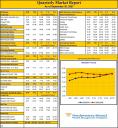By Emmett Wright, CFA Chief Investment Officer,
Northwestern Mutual Wealth Management Company
October 2007
While the third quarter was unusually volatile, most categories of U.S. stocks finished the period higher. For the three-month period ended September 30, 2007, the S&P 500® Index advanced 2.03%, and the Dow Jones Industrial Average and Nasdaq Composite Index each climbed around 4%. A closer look at the numbers shows that large-cap stocks dramatically outperformed small-cap issues, and growth outperformed value.
Although stocks have registered sizeable gains so far this year, the advances have not been broadly based. While the S&P 500 is up around 10% for the year, 40% of the stocks within the Index are down on a year-to-date basis. In general, domestically oriented areas of the market and those that are closely associated with housing have experienced the worst performance, while globally oriented segments outperformed. From a sector perspective, the best-performing industries so far this year have been the energy and materials (both of which are highly global in nature), followed by industrials, technology and telecommunications. The laggards have been the consumer-oriented sectors, including utilities, healthcare and, falling farthest behind, financials.
The third quarter’s strong market performance masked serious risks to the U.S. economy, as concerns about the subprime mortgage market mounted and a surprise drop in a key employment number was announced. In a period marred by financial crisis and worrisome economic data, massive injections of liquidity by world central banks and the surprisingly aggressive 50-basis-point cut in the target federal funds rate by the Federal Reserve in September soothed the markets home and abroad. This helped stocks around the globe to rebound solidly by quarter end.
During the period, the trade-weighted dollar declined to its lowest level in 11 years. Although a falling U.S. dollar seems to have fueled concerns domestically, it has had an opposite effect internationally. This has been most evident for emerging market countries, which have dominated the global markets all year. The MSCI Emerging Markets Index rose 13.7% during the third quarter (up approximately 34% for 2007). China, Brazil, and Turkey were the biggest contributors, adding to their outstanding year-to-date numbers. These countries have shown no signs of slowing down, despite years of outperformance, and have seen little impact from the turmoil in the global credit markets.
Even though foreign developed countries were not as fortunate as their emerging market counterparts, the MSCI EAFE Index still advanced a modest 2.25% for the quarter. Many of the elements that caused concern here in the U.S. also played out overseas. Uncertainty and speculation about the extent of global credit-tightening and the direction of interest rates in European and other developed nations have created a challenging environment for investors.
Despite the positive backdrop created by the beginning of a monetary easing cycle, the domestic economy has significant challenges to wrestle with in the months ahead. The housing situation continues to deteriorate, with home prices posting the steepest decline in 16 years, according to the S&P/Case-Shiller® Price Index. Inventories of unsold houses have pushed above 10 months, as buyers anxiously wait on the sidelines for signs of a bottom. Housing is seen as a critical component in assessing whether the consumer will continue to support the economy. Data for August showed consumer spending, which was bolstered by a strong labor market, rose a solid 0.6%, the best showing in four months, and better than the expected 0.4%.
Although food and energy prices have been on the increase, the market has been reassured by a relatively low inflation level. The Personal Consumption Expenditures Deflator (PCE) for August showed overall prices increased only 1.8% year over year. The PCE is one of the Federal Reserve’s closely watched inflation indicators; readings below 2 percent are considered to be in the Federal Reserve’s comfort zone. Low inflation continues to reassure investors that future purchasing power will not be eroded.
The market is cautious as we move into the third quarter earnings reporting period. With somewhat guarded estimates of 3.8% earnings growth, according to Thomson Financial, there is plenty of room for positive surprises to further support stocks.


Copied with permission from Northwestern Mutual Wealth Management Company “Wealth & Planning” October 2007, Issue 2, Volume 1
